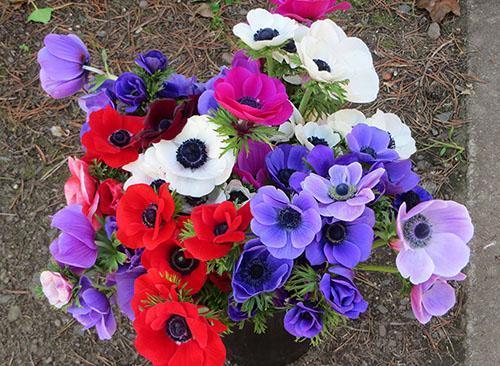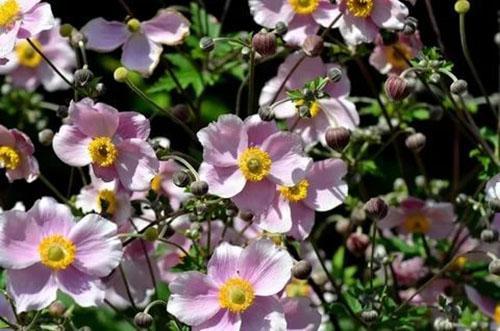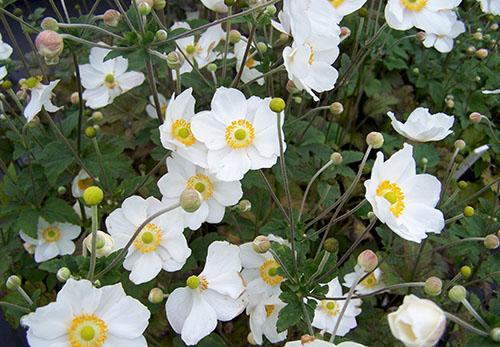We grow various types and varieties of anemones in the country
 Anemones, photos of which show the beauty of these plants, are represented by 172 species. But the variety of these garden flowers is not limited to this figure: many varieties have been bred that have an original appearance. They will decorate any flower bed and site.
Anemones, photos of which show the beauty of these plants, are represented by 172 species. But the variety of these garden flowers is not limited to this figure: many varieties have been bred that have an original appearance. They will decorate any flower bed and site.
The second name of anemones is anemone, or "Daughter of the Winds": this is how the name of plants is translated from Greek. Delicate flower petals begin to flutter at the slightest breath, gently swaying on their long and thin peduncles.
Anemone hybrid (Anemone × hybrida)
Hybrid anemones are a species artificially created by flower breeders for use in landscape design. They are obtained by crossing the Japanese variety with Anemone vitifolia.
Examples of varieties:
- "Queen Charlotte" with semi-double flowers of deep pink color.

- 'Honorine Jobert' with white petals.

- ‘Rosenschale’, whose stems reach a height of 60–85 cm. It has large pink flowers.

Most varieties of the species bloom in September-October, and ends only with the onset of constant cold weather.
Dubravnaya (Anemone nemorosa)
 This variety is also called "white" for the natural color of the petals. On the basis of the plant, varieties were bred with other colors: pink, lilac, bluish. The structure of a flower can be either simple or semi-double. The height of the stems is small - only 20-30 cm, and the diameter of the flowers does not exceed 3.5 cm.
This variety is also called "white" for the natural color of the petals. On the basis of the plant, varieties were bred with other colors: pink, lilac, bluish. The structure of a flower can be either simple or semi-double. The height of the stems is small - only 20-30 cm, and the diameter of the flowers does not exceed 3.5 cm.
The oak anemone blooms in spring - almost immediately after the snow melts. The flowering period lasts almost a whole month. Already in June, the leaves begin to acquire a yellow tint, and by the height of summer they completely dry out. The variety reproduces by seeds, but because of their poor preservation, bush division is more often used. You can appreciate the modest beauty and features of this anemones from the photo.
The oak anemone has an important advantage - unpretentiousness in the climate of the middle zone. The "historical" homeland of the plant is the forests of central Russia, where it can be seen in the spring forest. Therefore, in the garden, the white anemone grows easily: it is enough to plant it in a shaded corner, because in nature it is under the canopy of trees. She also loves moisture.
Another feature of the variety is the strong branching of the rhizome. If you do not control the process of growth, then soon the oak anemone fills a vast area in the garden. It is also recommended to pick off old flowers so as not to aggravate the situation by self-seeding.
There are artificially bred varieties:
- ‘Alba Plena’ - double white flower;

- 'Allenii' is a rare cultivar with bluish pinkish petals;

- 'Robinsoniana' lilac color.

Crowned (Anemone coronaria)
 Crown anemone is perhaps the most popular plant species used for horticultural floriculture. The palette of shades and the variety of color structures are amazing. On the basis of this species, varieties with a high decorative effect have been bred. True, caring for such a flower requires some knowledge and attention, but following the rules will help make it a highlight of the garden.
Crown anemone is perhaps the most popular plant species used for horticultural floriculture. The palette of shades and the variety of color structures are amazing. On the basis of this species, varieties with a high decorative effect have been bred. True, caring for such a flower requires some knowledge and attention, but following the rules will help make it a highlight of the garden.
The plant prefers soils with the addition of lime.
The diameter of the flowers can be up to 8 cm in diameter. The variety prefers a warm climate (its homeland is the Mediterranean), where it grows up to 45 cm in height, but in a climate of the middle zone does not exceed 20 cm.This anemone is grown as an annual or special measures (shelter, digging up tubers) are used to save for the next year.
All plant varieties are divided into 2 broad groups:
- crown anemone de kan (‘De caen’) with a simple flower structure;

- anemone St. Brigid (‘St. Brigid’) with semi- and terry.

If you don't dig up the tubers for the winter or plant them in the fall, then flowering will begin in late May or early summer (depending on weather conditions). When planting in spring, it falls in mid-summer and is not very expressive, and the reappearance of buds coincides with the arrival of frost.
Popular varieties:
- Anemone "Admiral" with a raspberry color with a soft mother-of-pearl tint and emerald leaves. Plant height is approximately 20 cm.
- Fokker with purple-blue petals. The middle of the flower is unusual dark, almost black. It has a semi-double structure and looks luxurious in a flower bed.

- Anemone "Lord Lieutenant" is a spectacular plant with double flowers. Their color is blue, more intense than that of "Mr. Fokker", and the same dark middle. The variety goes well with other flowers in the garden and does not interfere with them.

- "Bicolor" - boasts original white petals. A bright purple stripe runs around their center.

- "Holland" has red flowers with a snow-white center.
- Anemone "Governor" - another bright variety, colored scarlet.
 Differs in high doubleness and white color of the petals at their base. The plant has multiple lush, black stamens.
Differs in high doubleness and white color of the petals at their base. The plant has multiple lush, black stamens. - 'Sylphide' is a raspberry variety.
- Anemone "De Caen" Mix - suitable for those who want to diversify their flower bed with a scattering of bright colors. Their color can be varied: from light to dark saturated.
- Mount Everest anemone is a plant with neat flowers of increased doubleness. Numerous petals, collected almost in the shape of a ball, have a light golden center.
 They are painted in snow-white color.
They are painted in snow-white color.
Forest (Anemone sylvestris)
 This anemone is perennial, because it feels good in temperate climates and tolerates winter cold well. She prefers light soils. It grows quickly, forming fluffy cushions of green leaves. The height of the plant varies from 25 to 50 cm. Its slightly drooping flowers are small (from 3 to 5 cm), painted white. They decorate the site in late May or early June, and the flowering period lasts 2-3 weeks.
This anemone is perennial, because it feels good in temperate climates and tolerates winter cold well. She prefers light soils. It grows quickly, forming fluffy cushions of green leaves. The height of the plant varies from 25 to 50 cm. Its slightly drooping flowers are small (from 3 to 5 cm), painted white. They decorate the site in late May or early June, and the flowering period lasts 2-3 weeks.
Forest anemone blooms longer in the shade than in an open area.
Artificially bred plant varieties with larger (about 8 cm in diameter) and double flowers.
Tender (Anemone blanda)
Plants are miniature: they rise above the ground by only 5-10 cm. Flowers, similar to daisies, appear in the spring for 2-3 weeks. It grows both in sunny and semi-shaded areas. The colors of the blanda anemones are varied.
Popular varieties:
- "Charmer" with dark pink, almost purple petals.
- The 'Pink Star', or 'Pink Star', features delicate lavender flowers with a pink tint.
- Anemone "Blue Shades" is colored in soft blue, which is reflected in the name of the variety: it translates as "blue shadow". A popular plant with a modest but charming appearance.

- "Radar" is a garden variety with purple petals.
- "Purple Star" has a two-tone color: the white center effectively harmonizes with the basic amethyst tone.

Hubei (Anemone hupehensis)
 The height of the Hubei anemone is from 50 to 120 cm. The flowers do not differ in their large size - their diameter is about 5–7 cm, but they look very neat and elegant. They decorate the bush for 2 months: August and September.
The height of the Hubei anemone is from 50 to 120 cm. The flowers do not differ in their large size - their diameter is about 5–7 cm, but they look very neat and elegant. They decorate the bush for 2 months: August and September.
Popular varieties:
- ‘Kriemhilde’, which grows well in shaded areas. Its flowers are semi-double, colored in a rich pink-purple.
- 'Splendens' is a red variety.

- The ‘September Charm’ is a tall plant bred in England and in good conditions reaches 1.2 m. The color is pale pink, with a slight gradient transition from an almost white edging to a more saturated center.

Japanese (Anemone japonica)
 Japanese anemone is a small bush, the height of which does not exceed 40 cm, with dark-colored leaves. The colors of the petals are diverse.Flowers are grouped into inflorescences. Anemone japonica was renamed Anemone hupehensis during botanical research, and today its name is Anemone scabiosa.
Japanese anemone is a small bush, the height of which does not exceed 40 cm, with dark-colored leaves. The colors of the petals are diverse.Flowers are grouped into inflorescences. Anemone japonica was renamed Anemone hupehensis during botanical research, and today its name is Anemone scabiosa.
The flowers of anemones in their natural habitat are perennial, and in the middle lane they may not withstand winter frosts. But gardeners love them for their beautiful and abundant flowering, albeit short-lived. Growing a plant requires attention, although it is not particularly difficult. The main thing is to find a suitable place for it, based on the preferences of each variety.